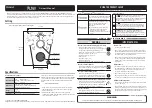
Page 13
omega
.com
CONFIGURATION
Cable Shield.
In general, the cable shield and its bare drain
wire should be left unconnected at the user equipment end of
the cable to minimize “ground loop” problems.
Pulse Output Configuration.
A p ulse o utput i s s tandard
on all models. Since this is an isolated output, the external
equipment must include a DC power source to regenerate the
pulse from the open-collector output (transistor equivalent
of a contact closure). A pull-up or pull-down resistor may
be needed if not included in the user equipment as shown
in the diagrams. Both the power source and resistor may be
supplied internally in some types of control and monitoring
devices. If not, as for most PLC discrete input modules, they
must be added externally at the module input terminals. The
pulse output rate in volume units/pulse can be set by the user
via the SETP tab on the meter’s setup menus.
Because the pulse output
is set by the user, care must be
taken to assure the output pulses do not exceed the
maximum frequency of the meter while also ensuring a
reasonable resolution.
K-factor: Remember that SETP is expressed in units totaled
per output pulse (G/P if using gallons) while K-factors are
expressed in pulses per gallon (P/G.) To determine K-factor
from SETP, divide 1 by SETP (if SETP is expressed in gallons.)
Conversely, 1 divided by the K-factor equals SETP
FMG470 Series
meters that were initially configured as
battery
powered units have a maximum output frequency of
150 Hz.
Those that were initially configured as powered
units have a
maximum output frequency of 200 Hz.
Because all pulse outputs (SETP) are configured in (rate) units
totaled per pulse, all sizes of meters can be configured with
the same SETP values. For example, if your rate is chosen as
gallons per minute (GPM) the table below applies.
Pulse Units.
The units of measure of SETP are independently
selectable and are not tied to rate or total. Upon change of the
SETP unit, the pulse output may take up to 10 seconds, or the
duration of one pulse (whichever is longer) to take effect.
If Pulse Output is Inconsistent.
The PDAMP filter may need
to be increased.
Pulse Width Timing.
The unit and value of SETP must be
chosen to keep the duration between meter pulse outputs to
less than 500 seconds.
Pulse Timing in Battery Powered Units.
The output pulse
width in battery powered units is short and varies with pulse
frequency. (See table)
SETP
Flow Rate at 1
Hz (GPM)
Flow Rate at
200 Hz (GPM)
Powered Meters
Flow Rate at
150 Hz (GPM)
Battery Powered
Meters
0.1
6
1200
900
0.2
12
2400
1800
0.3
18
3600
2700
0.4
24
4800
3600
0.5
30
6000
4500
0.6
36
7200
5400
0.7
42
8400
6300
0.8
48
9600
7200
0.9
54
10800
8100
1.0
60
12000
9000
Lower frequency output pulses (1 pulse for some particular
number of gallons) can also be set.
Any output frequency can be determined by:
Rate (units/minute) ÷ SETP (units/pulse) = pulse/minute
Hz = pulse/minute ÷ 60 seconds / minutes
For reference/comparison only
K-factors and the equivalent SETP values for old style
WMX units are shown below.
WMX
4”
6”
8”
10”
12”
K-Factor
16.36
6.31
3.34
2.15
1.53
SETP
0.06*
0.16
0.30
0.47
0.65
*Note that you would need to choose
a SETP value of 0.1 for the 4”.
Output Pulse Width of Battery Powered Units
Output Pulse Frequency
Output Pulse Width as a Percentage of
the Pulse Period
(Pulse period = 1000 milliseconds/frequency)
Zero to 1 Hz
Multiply the pulse
period by 0.01
= Output Pulse
Width (ms)
1 to 20 Hz
Multiply the pulse
period by 0.05
= Output Pulse
Width (ms)
20 to 100 Hz
Multiply the pulse
period by 0.1
= Output Pulse
Width (ms)
100 to 150 Hz
Multiply the pulse
period by 0.15
= Output Pulse
Width (ms)
Example: If frequency = 20 Hz then the pulse period = 50 milliseconds and
pulse width = (.05 x 50 milliseconds) = 2.5 ms
FMG470 Series








































